If you’ve been waiting since PMA 2009 for plenty of cameras to ogle at, today’s your day. Canon just unveiled SIX (!) new digital cameras today, including the much-awaited successor to the G10, the PowerShot G11, along with a pleasant surprise - the S-series of ‘mini G’ cameras is back with the PowerShot S90.
First off is the new PowerShot G11, Canon’s latest prosumer camera. Canon seems to be backing out of the megapixel race with this camera since they probably know photo enthusiasts aren’t easily fooled by insane, ever-increasing megapixel counts (usually accompanied by an increase in noise, decrease in burst speed and little to no ‘real’ resolution advantage). Canon has opted to fit the new G11 with a 10 megapixel CCD (versus 2008’s G10 14.7 megapixel CCD). With the new image sensor (and despite it not being a CMOS) along with improved noise processing, Canon claims that the PowerShot G11 will be able to out-perform its predecessor in terms of noise by two stops.
Next up is the Canon PowerShot S90, which is essentially the ‘mini G11′ (a little refresher: the S-series have always been the ‘smaller and lighter’ versions of their G-series counterparts). The S90 features the same sensor as the Canon G11, a brand new 3.8X lens (that starts at a bright f2.0!), full manual controls, RAW mode and 3 inch LCD stuffed into a body that’s closer to Canon’s Digital ELPHs in terms of form-factor, size and design. Naturally, the S90 will most likely perform as well as the Canon G11, seeing they share the same image sensor and supposedly, noise reduction algorithms.
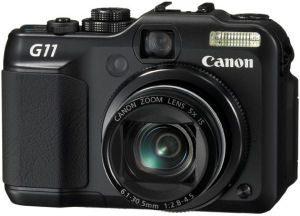
Canon PowerShot G11
(Prosumer compact camera)
- 10 effective megapixels
- 28 – 140 mm (f2.8 – f4.5) 5X optical zoom lens
- Optical image stabilization
- 2.8 inch rotating LCD (460,000 pixels); optical viewfinder available
- Full manual controls with RAW mode and hotshoe
- Canon claims improved image quality with its anti-noise system (sensor and processing will give the G11 a 2 stop noise advantage over its predecessor)
- Similar ‘retro’ body design to 2009’s G10
- VGA 30 FPS movie mode with sound (Disappointed yet, movie fans?)
- Takes SD/SDHC memory cards
- Uses a lithium-ion battery (390 shot battery life)
- Available in October for $500
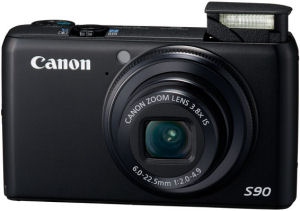
Canon PowerShot S90
(Prosumer compact camera)
- 10 effective megapixels
- 28 – 105 mm (f2.0 – f4.9) 3.8X optical zoom lens
- Optical image stabilization
- 3 inch LCD (460,000 pixels)
- Lens control ring (the rim around the lens) can be used to adjust zoom or assigned to camera settings
- Full manual controls with RAW mode
- VGA 30 FPS movie mode with sound
- Takes SD/SDHC memory cards
- Uses a lithium-ion battery
- Available in October for $430
On the other hand, the more consumer oriented PowerShot SX20 IS ups the megapixel count to 12 while keeping the 20X super zoom lens, full manual controls and body design of the SX10 it updates. The Canon PowerShot SX20 also features an improved movie mode (it now records 720p clips) and RAW mode. The PowerShot SX120 IS is a budget, compact super-zoom camera - designed to be a less featured, more affordable alternative of the SX20 (the SX120 also has less zoom than the SX20)
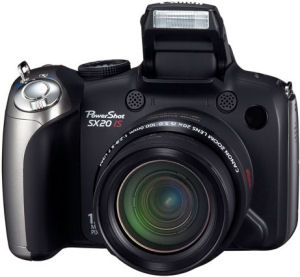
Canon PowerShot SX20 IS
(Super-zoom camera)
- 12 effective megapixels
- 28 – 560 mm (f2.8 – f5.7) 20X optical zoom lens
- Optical image stabilization
- 2.5 inch flip out and rotate LCD with EVF
- Full manual controls with RAW mode and hotshoe
- 720p 30 FPS movie mode with stereo sound
- Takes SD/SDHC memory cards
- Uses 4 AA batteries
- Available in September for $400
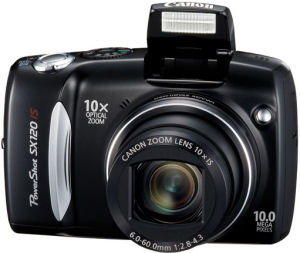
Canon PowerShot SX120 IS
(Compact super-zoom camera)
- 12 effective megapixels
- 36 – 360 mm (f2.8 – f4.3) 10X optical zoom lens
- Optical image stabilization
- 3 inch fixed LCD
- Full manual controls
- VGA 30 FPS movie mode with sound
- Takes SD/SDHC memory cards
- Uses 2 AA batteries
- Available in September for $250
Canon didn’t leave anyone out today - For those looking for a small and stylish camera, they have the new PowerShot SD980 Digital ELPH (also known as the Digital IXUS 200 around the world) and PowerShot SD940 Digital ELPH (AKA Digital IXUS 120). The SD980 Digital ELPH/IXUS 200 is Canon’s first-ever digital camera which features a touchscreen (a high-resolution one at that) and it’s set to compete with the likes of the Sony Cyber-shot TX1 and Nikon Coolpix S70. The Ixus 120 sets out as an incremental upgrade to the IXUS 100 announced and reviewed earlier this year.
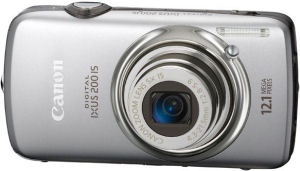
Canon PowerShot SD980 IS Digital ELPH
AKA Digital IXUS 200
(Ultra-compact camera)
- 12 effective megapixels
- 24 – 120 mm (f2.8 – f5.9) 5X optical zoom lens
- Optical image stabilization
- 3 inch touchscreen
- User interface tailored for touchscreen; supports gestures
- No manual controls
- 720p 30 FPS movie mode with sound
- Takes SD/SDHC memory cards
- Uses a lithium-ion battery
- Available in October for $330
- Comes in your choice of baby blue, silver, gold and purple
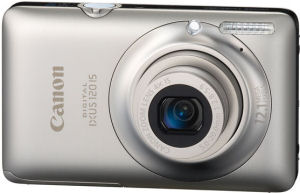
Canon PowerShot SD940 Digital ELPH
AKA Digital IXUS 120
(Ultra-compact camera)
- 12 effective megapixels
- 28 – 112 mm (f2.8 – f5.9) 4X optical zoom lens
- Optical image stabilization
- 2.7 inch LCD
- No manual controls
- 720p 30 FPS movie mode with sound
- Takes SD/SDHC memory cards
- Uses a lithium-ion battery
- Available in September for $300
- Comes in your choice of silver, black, brown or blue

I want to kiss Canon on the mouth for the G11 & S90. I just hope the image quality lives up to the amazing-sounding specifications!
Canon G11 is it 12 Megapixels CMOS sensor or 10 Megapixels CCD?
The Canon PowerShot G11 will use a 10 megapixel CCD, 1/1.7 inches in size. Canon says that this sensor will contribute to reduced noise (despite it not being CMOS)
G11 great sensor but where is the full HD recording like the SX1 ?
The SX1 is amazing but too big for the pocket, a G11 with full HD would be my ideal camera but until that happens I will wait for the G12 which I expect will have full HD. ( Owner of a G10 and a SX1 )
Hmm, it seems that Canon thinks that video isn't as large a concern as image quality on a prosumer camera like the G11. Unfortunately I suppose you'll have to wait out for HD video on the G-series, since the G11 only has a conventional VGA movide mode.